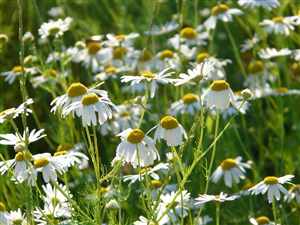Chamomile (Matricaria recutita, Chamaemelum nobilis)
Main Facts about Chamomile

Using Chamomile
Used as a tea, salve, vapor, or essential oil. A great source of the amino acid tryptophan, which is converted into the neurotransmitter serotonin. Relaxes and makes you feel good. Great for stress and peaceful sleep.Extensive scientific research over the past 20 years has confirmed many of the traditional uses for the plant and established pharmacological mechanisms for the plant's therapeutic activity, including antipeptic, antispasmodic, antipyretic, antibacterial, antifungal, and antiallergenic activity. Tea also used externally to wash hair, skin inflammations, sunburn. Add to bath to relax. As a germ-killer an ingredient in numerous cosmetic and external preparations: ointments, creams, and gels used to treat cracked nipples, sore gums, and irritation of the skin. It is also used topically for wounds, burns, eczema, frostbite, diaper rash, bedsores, and hemorrhoids.Chamomile is a remedy for: Cold and flu, Anxiety, Arthritis, Constipation, Hemorrhoids
Cooking with Chamomile
Flowers good in salads.Dried flowers commonly used to make herb infusion or a refreshing tea to serve various medicinal purposes .How to grow Chamomile
Prefers full sun, light, sandy, and moist soil. Often found along roadsides and can become rather weedy. Needs a fair amount of water and a brief cool season, doesn't grow well in tropical or arid environments.| Cayenne Pepper |
Chokecherry
|